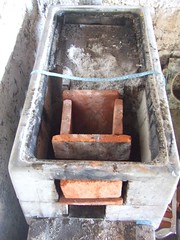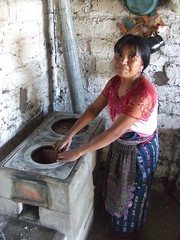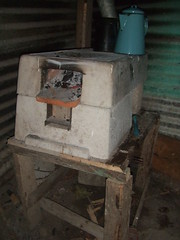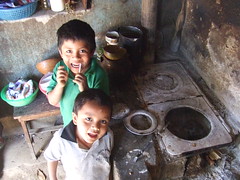Installing the ONIL Stove in Guatemala
 Last year I had the good fortune to link up with a small NGO in Panajachel, Guatemala - Mayan Families - and they were kind enough to let me help them install indoor air pollution (IAP) stoves in villages around Lake Atitlan. I had been hand building my own version of the Justa stove nearby, but have been interested in the ONIL (developed by Don O'Neal and made locally by HELPS International) - because it is a stationary masonry stove that is mass produced and does not require any mortar for construction... it installs in just a few hours! There are now tens of thousands of the in the field, but the web documentation of installation experience is slim (see here for an animation of just the construction aspects) so I thought that I would describe my experiences.
Last year I had the good fortune to link up with a small NGO in Panajachel, Guatemala - Mayan Families - and they were kind enough to let me help them install indoor air pollution (IAP) stoves in villages around Lake Atitlan. I had been hand building my own version of the Justa stove nearby, but have been interested in the ONIL (developed by Don O'Neal and made locally by HELPS International) - because it is a stationary masonry stove that is mass produced and does not require any mortar for construction... it installs in just a few hours! There are now tens of thousands of the in the field, but the web documentation of installation experience is slim (see here for an animation of just the construction aspects) so I thought that I would describe my experiences.
 The 2 main components are cast from concrete in a well organized end efficient factory, and delivered to installers by the truckload, with all of the other parts besides the 11 cement blocks which are used as a base - the kit is beautifully simple to work with, a crew of 2-3 installers can construct a half dozen a day, and families can begin cooking on them before we have even driven off. The process starts with the leveling of the ground at the proposed site in the kitchen (often where the old stove - a 3 stone fire or similar crude cooking structure - had been), an important step if the plancha is to be level and the stove stable. These stoves are designed to meet the needs of the local cooks, who daily cook tortillas and who would like to use their stove with several pots at a time, problematic if the metal surface is tilted.. This leveling process can be the most time consuming of the steps, requiring the use of a level and preferably some river sand to get it right; it is easy to skimp on this, but don't do it! A base of unmortared cement blocks is quickly laid down, and then the bottom and top parts of the stove are ready to be put in place.
The 2 main components are cast from concrete in a well organized end efficient factory, and delivered to installers by the truckload, with all of the other parts besides the 11 cement blocks which are used as a base - the kit is beautifully simple to work with, a crew of 2-3 installers can construct a half dozen a day, and families can begin cooking on them before we have even driven off. The process starts with the leveling of the ground at the proposed site in the kitchen (often where the old stove - a 3 stone fire or similar crude cooking structure - had been), an important step if the plancha is to be level and the stove stable. These stoves are designed to meet the needs of the local cooks, who daily cook tortillas and who would like to use their stove with several pots at a time, problematic if the metal surface is tilted.. This leveling process can be the most time consuming of the steps, requiring the use of a level and preferably some river sand to get it right; it is easy to skimp on this, but don't do it! A base of unmortared cement blocks is quickly laid down, and then the bottom and top parts of the stove are ready to be put in place.

 ash, so that only the top surface gets hot, while maintaining a very high internal (combustion chamber) temperature so that the smoke is completely burned and the combustion efficiency is high. The design is such that the hot gases flow only through a narrow space just below the plancha, so that the heat is not wasted raising the temperature of the body too much. The family is hopefully nearby, helping with the process, and learning about how their stove is constructed - and how/why it works so well - because they have to maintain it for years to come. The scrubbed plancha is now put in place, the stove is again checked for levelness, and the chimney is ready to be installed.
ash, so that only the top surface gets hot, while maintaining a very high internal (combustion chamber) temperature so that the smoke is completely burned and the combustion efficiency is high. The design is such that the hot gases flow only through a narrow space just below the plancha, so that the heat is not wasted raising the temperature of the body too much. The family is hopefully nearby, helping with the process, and learning about how their stove is constructed - and how/why it works so well - because they have to maintain it for years to come. The scrubbed plancha is now put in place, the stove is again checked for levelness, and the chimney is ready to be installed.
At this point in the process, you want to begin laying the "first fire", so that the cook of the house can be boiling water while the installers are still there to answer questions - it is very important that some instruction be given, since tending a fire in a stove like this is quite different from what they are used to. Smaller split wood is necessary because of the reduced fuel opening, more frequent adjustment of the fuel may be required, and we want to demonstrate that less fuel can be required to accomplish the same cooking tasks. Studies have shown that these kinds of improved stoves do not naturally result in reduced fuel consumption, because by directing the smoke out of the house the cook may no longer maintain the fire at a minimum size - wasting wood and polluting the outdoor environment unnecessarily (http://ehs.sph.berkeley.edu/krsmith/publications/2009%20pubs/Biomass_Bioenergy_2007.pdf
 A hole is drilled in the roof of the house, the chimney is fixed in place with silicone sealant so that rain does not get in, the workspace is cleaned up (the old stove is often removed, to provide an extra incentive to use the new and improved model), and final instructions are delivered for properly maintaining their new cooking appliance. Hopefully, the water on the stove has already come to a boil with a surprisingly small amount of fuel, and another family is happy to start cooking in a neater/cleaner kitchen with no smoke to reduce their quality of life!
A hole is drilled in the roof of the house, the chimney is fixed in place with silicone sealant so that rain does not get in, the workspace is cleaned up (the old stove is often removed, to provide an extra incentive to use the new and improved model), and final instructions are delivered for properly maintaining their new cooking appliance. Hopefully, the water on the stove has already come to a boil with a surprisingly small amount of fuel, and another family is happy to start cooking in a neater/cleaner kitchen with no smoke to reduce their quality of life! But not all works as easily as we would hope - without proper education and best practices reinforcement their new stove may not be used as intended, or it may not please the family as much as we would like. Which brings me to the subject of what could we do better when installing stoves like the ONIL (besides bringing down the price, which can be hard with full featured stoves like these, with an abundant amount of metal parts), and what happens when we don't try hard enough:

- There is no substitute for good stove construction and installation - most of the ONIL is nearly bombproof, but if it is not placed on a durable and level base then no one will be happy. Problems can occur when installers are paid by the stove, since this provides incentives to move quickly to the next home - perhaps scrimping on some aspects of the installation and instruction.
- Have the family build it with you, since this creates a sense of ownership and drills in what it takes to do at least the minimal amount of maintenance. Work side-by-side and discus every part and feature - we can't always avoid subsidies, but we can instill a a sense of pride and ownership that may be a decent substitute for paying full price
- Definitely take the time to build that first fire and prepare even a simple dish (if only tea or tortillas) with the family, so that you get the chance to discuss fire tending and stove operation. Even better is if you can take the time to visit the household over the course of the first few days, to reinforce best practices (splitting of wood into small pieces, always using a pot lid, not overloading the stove, drying of wood overnight on the stove surface, always using the grate, covering the fuel entrance when not in use, removing the buildup of ash daily, etc.) and discourage bad.
- Anticipate that maintenance will be required, and arrive at a plan for encouraging that it take place. Cleaning the chimney is the most alien of the new chores, because many cultures have no experience with this task - and if it becomes blocked then it may never get cleaned/replaced. Similarly, if the combustion chamber bricks break and there is not a supply of replacement parts nearby then it is likely that the whole interior of the stove will become the combustion chamber (so efficiency and overall performance will suffer).
- Try to investigate and understand the sociocultural environment that the stove will exist in - gender issues, work division, different uses of the stove (meal types, impact on home heating, holiday needs, etc.) - and remember that over the course of the year different stoves and fuels may be traditionally used.
good at cooking with this stove is a huge plus - theoretical stove tending advice does little for the instruction process. One challenge is that such quality stove costs extra so we must keep looking for ways to reduce the manufacturing and distribution costs of new stoves, so that those that need them most both value their combination of attributes and can afford them. It is unfortunate that the financial incentives - the savings due to the need for less firewood - may not be clear enough to users, or because there are poor mechanisms for saving money in the developing world; as well, present bias can interfere with people's ability to sufficiently value a purchase with long term benefits.
Below are some examples of the improper installation or use of ONIL stoves - to prevent this from happening regular field visits are suggested, it must be frequently emphasized that modifications to the stove will result in poor performance (which may not be obvious to the cook, since unfortunately saving firewood is not always a high priority) both due to fires which are too large and excessive air carrying away valuable heat, and it can be necessary to repair stoves which have been hacked or are broken. The most common alteration is an enlargement of the fuel entrance, and removal of the combustion chamber and grate so that larger pieces of wood (or more sticks at one time) can be used - we shouldn't be surprised by this since cutting wood to the smaller sizes required for many improved stoves takes extra time and energy. The only way to prevent this is to demonstrate the fuel savings possible when the stove is operated correctly, and since they don't come with instruction manuals you need that hands on approach... and lots of encouragement, since changing one's cooking practices can be an awkward process.



Repairing a hacked stove in Santa Catarina Palopo - all stoves were modified in this fashion before installation.



Re-purposed ONIL planchas (where did the rest of the stove go?), and installation of a hacked stove on a horrible base.






































